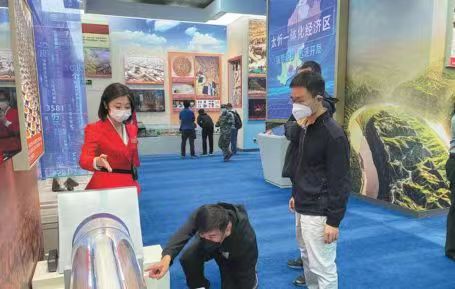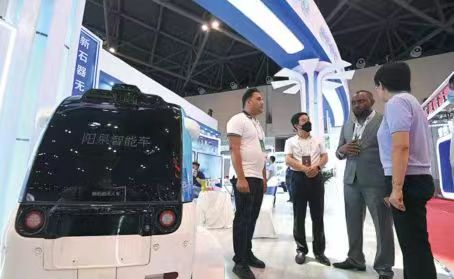
A guide introduces an exhibit from Shanxi at the Forging Ahead in the New Era exhibition held in Beijing. [Photo by Hou Jin for China Daily]
Cooperation between cities, upgrade of traditional industries and cultivation of emerging sectors create opportunities for businesses
September was a busy month for Shanxi, a province in North China, especially in the areas of industrial cooperation and investment promotion, with a range of important events taking place.
That month's tight schedule began with the 2022 Taiyuan Energy Low Carbon Development Forum held in the provincial capital of Taiyuan on Sept 1-3.
As an important event for China's energy industry and one of the high-profile international shows in Shanxi, the forum included meetings and exhibitions featuring energy revolution, low-carbon development and environmental protection.
The forum was used by the host province of Shanxi as a showcase for the achievements of its energy revolution campaign. The campaign focuses on upgrading the coal mining industry for efficient and clean production and fostering clean energy industries for a greener and low-carbon path of development.
The event was also used as a platform to facilitate business cooperation. Shanxi secured 71 investment projects funded by domestic and overseas businesses at the forum, with combined investment totaling 88.53 billion yuan ($12.30 billion).
Two days after the energy forum, a collective event for signing agreements, groundbreaking and operations of investment projects was held in various economic zones throughout the province on Sept 5.
This was the ninth time Shanxi held a collective event for investment projects this year.
The booming investment in the economic zones and industrial parks also marked the recognition by investors of Shanxi's improving business environment and solid economic growth, officials said.
Shanxi's GDP grew 9.1 percent in 2021 compared to the previous year. The growth ranked it third nationwide. The year-on-year growth for the first half of the year reached 5.2 percent, ranking it second among all provinces, municipalities and autonomous regions in the country.
Shanxi's authorities have made great efforts to improve its business environment to attract investors.
"We should continue to make efforts to create a predictable, reliable and sustainable business environment for enterprises based on the principles of the rule of law and market orientation and in line with international standards and practices," Shanxi Governor Lan Fo'an said at the sixth session of the 13th Shanxi People's Congress in January.
He added that the government hopes to build a harmonious government-corporate relationship to jointly boost local development.
The latest measures to improve business environment in Shanxi include practices to streamline business approval procedures, reduce administrative service costs, improve administrative service efficiency through the use of online platforms and digital technologies, as well as whole-process assistance from officials to help businesses grow, said an official of the Shanxi Bureau of Administrative Services.
The number of newly registered businesses has grown quickly because of these efforts. The data showed that the number of market entities in Shanxi reached 3.64 million in July, an increase of 21.6 percent from the same period last year.
Among the string of investment promotion activities in Shanxi on Sept 5, the event to promote the construction and development of the Taiyuan-Xinzhou Integrated Economic Zone was the most eye-catching.
Local leaders including provincial Party secretary Lin Wu and Shanxi Governor Lan witnessed the groundbreaking of projects in the emerging economic development zone.
The integrated economic zone was established on Dec 29 to form a cluster between the two central Shanxi cities of Taiyuan and Xinzhou and promote integrated economic development in the province.
The cluster is supposed to host industries relocated from the Beijing-Tianjin-Hebei region, where an integrated regional development plan is now in place.
The groundbreaking ceremony saw 64.6 billion yuan worth of investment projects settle in the Taiyuan section and 31.2 billion yuan worth of projects in the Xinzhou section of the integrated zone. The operation of the projects, mostly in the high-tech and emerging sectors, is expected to turn the zone into a new growth engine for Shanxi, officials said.
Xinzhou was not the first city to integrate with Taiyuan. An earlier development program had paired up Taiyuan and its southern neighbor Jinzhong. The two cities are linked by the Shanxi Transformation and Comprehensive Reform Demonstration Zone, which is now the biggest integrated development zone in Shanxi.
Over the past few years, the zone saw its GDP more than double from 42.1 billion yuan in 2017 to 86.1 billion yuan in 2021, the data showed.
The transformation zone, founded in November 2016, has been a major test site for Shanxi's economic transformation. It features the upgrading of the province's coal mining and other heavy industries and fostering emerging industries as new growth drivers of the economy.

Chinese and foreign representatives talk about possible cooperation at the 2022 Taiyuan Energy Low Carbon Development Forum. [Photo by Ruan Yang for China Daily]
Shanxi's transformation is an active response to the proposal by central authorities for the transformative development of resource-reliant regions in China, which requires both industrial upgrading and economic diversification.
Under the guidance of the central authorities, Shanxi province has devoted much energy to upgrading traditional industries and cultivating strategic emerging industries.
One successful case of industrial upgrading is Gaohe Energy, a coal-mining unit of Lu'an Chemicals Group based in the southeastern Shanxi city of Changzhi. The company's digitalized coal mines were included in the first batch of "demonstrative smart coal mines "on Sept 8.
Wang Shu, an executive in charge of automatic operations at Gaohe Energy, said the company used such cutting-edge technologies as 5G, the internet of things, robots and automatic coal-cutting and conveying to modernize its operations.
"Through the connection of a 5G network with underground monitoring devices and production equipment, all the operations can now be controlled at the coordination center above the ground," Wang said. "This upgrading has led to great improvements in both efficiency and safety."
Shanxi has seen the development of 24 intelligent coal mines and 612 smart mining shafts. This achievement has put it at the forefront of coal mine digitalization in China.
While upgrading the traditional coal mining sector, Shanxi is also diversifying its energy industry into such sectors as wind, solar, geothermal, hydraulic, hydrogen fuel and coal-bed methane power. More than one-third of the electricity in Shanxi is now generated using new, clean and renewable energy resources.
The province has formed 10 major industrial chains in the area of emerging industries including advanced steelmaking, new energy vehicles, advanced equipment manufacturing, wind power equipment manufacturing, hydrogen fuels, photovoltaic equipment, modern biomedicine and semiconductors.
The combined operational revenues of the 10 industrial chains surpassed 330 billion yuan last year.